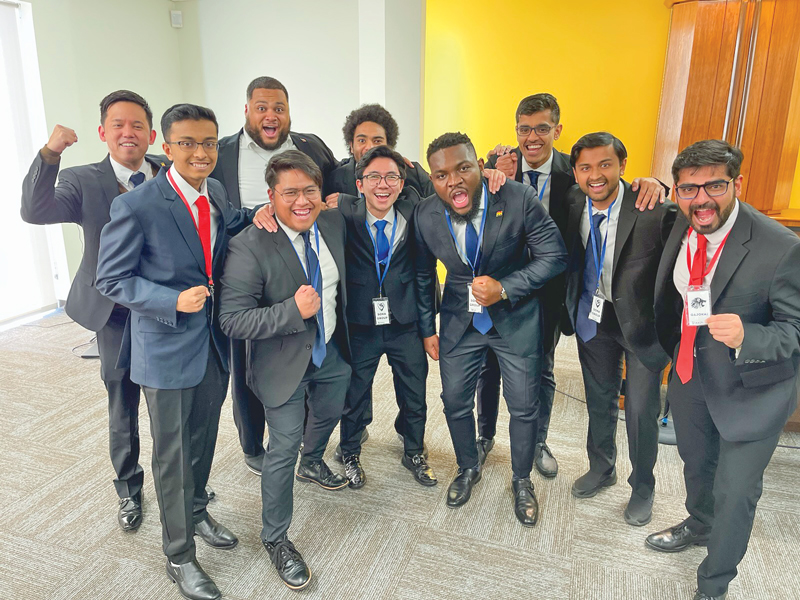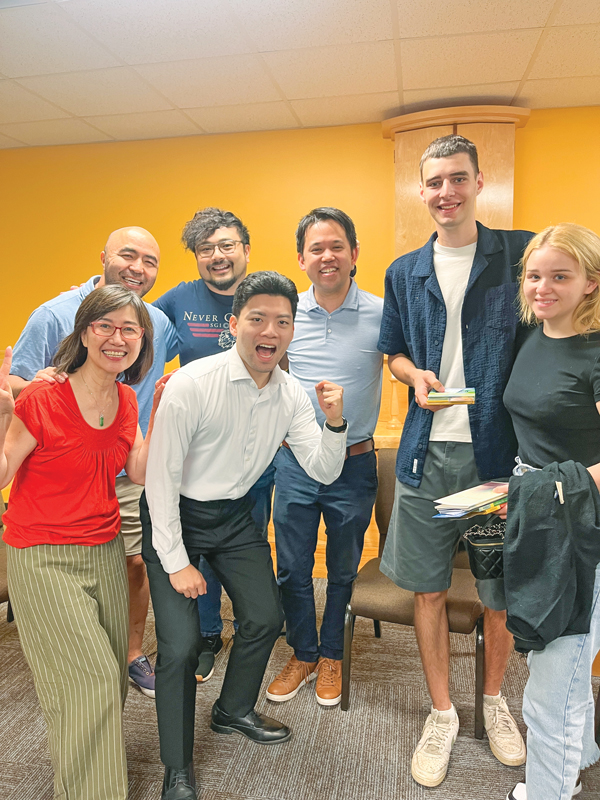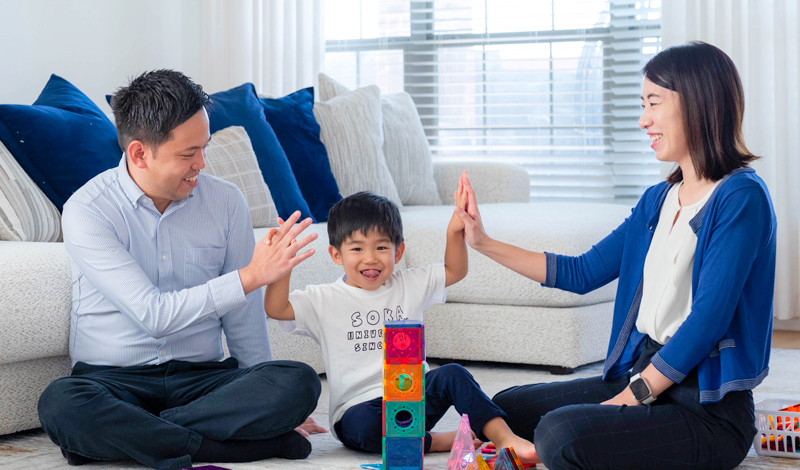Living Buddhism: Mariano, thank you so much for speaking with us. Today, you have a beautiful family—your wife, Masako, and your 3-year-old son, Masayuki Noah. It was also a hard-won family—one you waged multiple life-and-death battles to build.
Mariano Kimbara: We deeply appreciate this opportunity to share our experience. Masayuki did not come easily into the world, though we did everything in our power to pave the way. For nine years, in fact, we did, or tried to, Masako and I chanting fierce daimoku for a child of our own. Despite many procedures and unrelenting prayers, our efforts did not bear fruit. Once—just once—we came close, in 2021, but it ended in a pain almost too great to bear: the loss of our unborn daughter. There’s no denying it: To come so close after trying so long—it tested my faith. But in the end, our faith won over our grief. One does not give up in Buddhism. We became more determined than ever to realize our great dream of raising a successor to continue the path of Soka.
We decided to undergo several more medical procedures, and the happy news came that July—Masako was pregnant again. I spared no effort during this time—redoubling my efforts on the frontlines of kosen-rufu, as an employee at work and as a husband. As Nichiren Daishonin says, “Yet you must grit your teeth and never slacken in your faith” (“Letter to the Brothers,”The Writings of Nichiren Daishonin, vol. 1, p. 498).
The baby was a boy, and we decided to name him Masayuki—“one who advances correctly even through difficulty.”
Everything went smoothly until one week before his due date. To our shock, the final ultrasound revealed that Masayuki had not one but two serious conditions, one affecting the heart and the other, a genetic condition primarily affecting the liver. The second had no known cure, the doctors said, but it was the first—his heart—that posed the most immediate threat to his life.
He would need open-heart surgery after delivery, they said—the sooner the better. But they added that it might not be as soon as we’d hope—the hospital was overwhelmed by the COVID-19 crisis and was short on specialists and rooms for intensive care.
The genetic condition, the doctors told us, posed a longer-term threat to his well-being and development. This we could only keep careful watch over as he grew.
Looking at the sonograms, my wife said, “We’ll win with the Gohonzon!” Taking her hand, I added, “With stronger daimoku than ever.”
That night, we determined to wage a battle of faith—a united daimoku campaign, chanting many hours for his victory. From here on out, between meals, work and SGI activities, every spare moment of ours was spent chanting to the Gohonzon.

Masayuki arrived on time?
Mariano: One week later, yes. And the moment he did, he was taken away. My wife and I had maybe a minute each to hold him in our arms before they took him to the neonatal intensive care unit, where he stayed for two weeks under 24/7 monitoring.
During that time, it occurred to me that our son’s name was truly his—Masayuki, “one who advances correctly even through difficulty.”
Chanting powerful daimoku for our son, I realized what a tremendous mission he had to overcome his suffering and (this my wife never failed to remind me) to bring joy and laughter to the world. I saw many things in the NICU that I never would have had my son not brought me there. Masayuki, I realized, was teaching me things beyond words to describe.
There, his condition stabilized. But it took time to schedule his surgery.
Mariano: Eight months, in fact—far longer than normal. But in January 2023, we woke, Masako and I, in the early morning hours of the 20th, to chant in a room at the hospital. At 6:30, they came to take Masayuki from us. We did not know how long the surgery would last, but we knew we’d best prepare for a long wait. As one hour passed into the next, we chanted. As we did, we received calls and texts—from across the world—friends in faith were chanting intensely for the protection of our son. I can’t put into words how deeply we appreciated this then.
After seven hours, we learned the surgery was an absolute success.

Wonderful. And then you all moved that same year, from San Antonio to Dallas.
Mariano: That’s right. That April, we said our farewells and shared our family victory at the San Antonio Buddhist Center with those who’d been alongside us all those years we’d fought to have a child. We took our time getting to the exit, stopping for many hugs and goodbyes. One old friend of mine, a pioneer of kosen-rufu, tugged me aside, a challenge, as usual, in his smiling eyes.
“Mariano,” he began, “I’ve practiced, what … 56 years now? But you know, every day I wake up and say to myself, Today is the first day of my practice.”
His eyes held mine another moment while those words sank in. What truly mattered, he’d told me many times, was not what we’d done so far, but how we are fighting today. Then we left, as a family, for Dallas.
How was Masayuki’s health at that time?
Mariano: Much better. But I worried he carried other wounds. At his first SGI activity in Dallas, encircled by adoring faces, I remember how he shook with fear. And I wondered then how deeply engraved were his early memories in the hospital, where for him a circle of faces promised pain and a battle between life and death.
It took time, but he eventually calmed down. With every SGI activity, he seemed to open his heart a little more to others. Soon, he could be tickled and held and was very happy.
Not long after you arrived, you took your first trip as a family—a big one—to Japan.
Mariano: We made the trip in November 2023 to report to Ikeda Sensei our victory in bringing Masayuki into the world. We visited the Hall of the Great Vow for Kosen-rufu on the first of the month. Later that same day, we introduced Masayuki to my wife’s parents and my own, who were getting older.
On the 15th, we heard the news that Sensei had passed away. The news deeply saddened us, but I felt immense appreciation for the opportunity to report our victory before his passing.
The morning after New Year’s Day, I was at my mother’s house with her, Masako and Masayuki. We were all in the living room, Masako chatting with my mother while I played with Masayuki, when I felt a sudden wave of heat that grew until I found I’d broken into a sweat. I got to my feet without a word and made my way to the guest room at the far wing of the house to change into another pair of clothes. Masayuki toddled behind me on his newfound feet, which were soon the only thing I heard, my wife’s voice growing soft and then quiet.
The whole world, in fact, seemed to be growing soft—dim and hazy around the edges. Reaching the guest room, I made it as far as the bed when I heard the piercing cry of my son behind me: “Daddy!” And then the world went black.
What happened?
Mariano: I’d developed a peptic ulcer in my gut, which burst, resulting in a massive loss of blood by vomiting. Worse still was the infection the rupture caused, resulting in the rapid loss of over 60% of my white blood cells. When I told the doctors that my home-bound flight was set to depart the next day, they told me: “Had this happened in the air, you’d already be gone.”
In the air or on the ground, I couldn’t help but wonder whether I’d have survived if Masayuki hadn’t followed in my footsteps and cried out as he did when I collapsed.

How long were you in the hospital?
Mariano: One week. When I woke, it was to a stunning view of Mount Fuji from the hospital’s southwest-facing window. After some time, I checked my phone. My inbox was full of voicemails and texts. With great effort, I worked my way through the well-wishes and prayers, sending my thanks and assuring them I was OK.
After a while, I felt a strong desire to read something. Summoning all my will, I picked up my phone again and pulled up an essay by Sensei titled “April 2—A Time for Renewing Our Vow.” April 2 is the anniversary of the passing of Sensei’s mentor, second Soka Gakkai President Josei Toda. The essay recounts how Sensei, embodying the spirit of the oneness of mentor and disciple, strove to open the path for the continued growth of kosen-rufu.
When life is most painful, I thought, is precisely when one must take a stand.
And you returned home later that week?
Mariano: I did and threw myself with the full force of my being into my work, home life, SGI activities and home visits.
There were a number of young men who hadn’t been seen in a while. Their schedules, they said, were what prevented them from coming out.
Together is the best way to do visits—together instead of alone. With another men’s division leader, we visited the young men, including one who had begun working two jobs with little time to himself.
“Let’s challenge this together!” I said.
“In front of the Gohonzon!” added my friend, and the three of us faced the challenge squarely, chanting powerful daimoku together.
There was a youth meeting coming up, and we asked if he felt, despite everything, he could make it. “I can,” he said firmly. Later that month, he did and enjoyed the activity with the other youth, many of whom were struggling with the same kind of challenge.
Two young men have received their Gohonzon this year, while several others who’d stopped coming out long ago have begun coming out again.

How wonderful. In terms of your son’s health, was he in the all-clear?
Mariano: He had one more surgery to go—not as serious as the first, but no small matter either. I had full faith in our daimoku but worried for his heart, in the deeper sense of the word, which had begun to open up to others—to the warmth and love of his SGI family—and which seemed to have forgotten its former fear of grown-ups, remembered mostly as surgeons. I was worried that fear would return and he’d begin to shake again.
Instead, in the hospital, just hours before the surgery, he began to dance. It was delightful—almost as though Masayuki were reassuring me. I’m not afraid, he seemed to be saying. I’ve done this all before. Once again, we were able to witness the immense power of this practice.
It went well?
Mariano: It did. And it brought him no fear of people. If anything, it seemed to reinforce his trust of them—trust that had come slowly, surrounded by his loving SGI community.
These days, he is the youngest of us at every Soka 2030, joining me sometimes in welcoming members during my King Castle shifts. He likes to wave the SGI flag.
Masayuki underwent another assessment only a few months back. It was discovered that the genetic condition affecting his liver has yet to manifest any active symptoms.
The more people I supported, the more deeply I appreciated life and my son’s condition. Certainly, it has been his mission to overcome difficulties, teaching me all the while how to advance correctly in their midst—joyfully, with a brave and open heart.
You are reading {{ meterCount }} of {{ meterMax }} free premium articles

